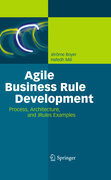
Agile business rule development: process, architecture, and jrules examples
Boyer, Jérôme
Mili, Hafedh
Business rules are everywhere. Every enterprise process, task, activity, or function is governed by rules. However, some of these rules are implicit and thus poorly enforced, others are written but not enforced, and still others are perhaps poorly written and obscurely enforced. The business rule approach looks for ways to elicit, communicate, and manage business rules in a way that allstakeholders can understand, and to enforce them within the IT infrastructurein a way that supports their traceability and facilitates their maintenance.Boyer and Mili will help you to adopt the business rules approach effectively. While most business rule development methodologies put a heavy emphasis on up-front business modeling and analysis, agile business rule development (ABRD) as introduced in this book is incremental, iterative, and test-driven. Rather than spending weeks discovering and analyzing rules for a complete business function, ABRD puts the emphasis on producing executable, tested rule sets early in the project without jeopardizing the quality, longevity, and maintainability of the end result. The authors’ presentation covers all four aspects required for a successful application of the business rules approach: (1) foundations, to understand what business rules are (and are not) and what they can do foryou; (2) methodology, to understand how to apply the business rules approach;(3) architecture, to understand how rule automation impacts your application;(4) implementation, to actually deliver the technical solution within the context of a particular business rule management system (BRMS). Throughout the book, the authors use an insurance case study that deals with claim processing. Boyer and Mili cater to different audiences: Project managers will find a pragmatic, proven methodology for delivering and maintaining business rule applications. Business analysts and rule authors will benefit from guidelines and best practices for rule discovery and analysis. Application architects and software developers will appreciate an exploration of the design space for business rule applications, proven architectural and design patterns, and coding guidelines for using JRules. Presentation covers all relevant aspects of the business rules approach: foundations, methodology, architecture, and implementation (based on IBM’s JRules)Agile business rule development is a low-risk methodology that produces immediate value to business stakeholders and avoids analysis paralysisAdditional material, including all deliverables for the insurance case study, is available on the companion website www.agilebrdevelopment.comAuthors combine for more than 25 years of business rule development in industry, in various capacities (project management, business analysis, architecture, and implementation) INDICE: Introduction to business rules. Business rules in practice. Agile Business Rule Development. Rule Harvesting. Prototyping and Design. Rule engine technology. Issues in designing business rule applications. IBM Websphere ILOG JRules. Issues in rule authoring. Rule authoring infrastructure in JRules. Rule authoring in JRules.-
- ISBN: 978-3-642-19040-7
- Editorial: Springer Berlin Heidelberg
- Encuadernacion: Cartoné
- Páginas: 400
- Fecha Publicación: 01/03/2011
- Nº Volúmenes: 1
- Idioma: Inglés
